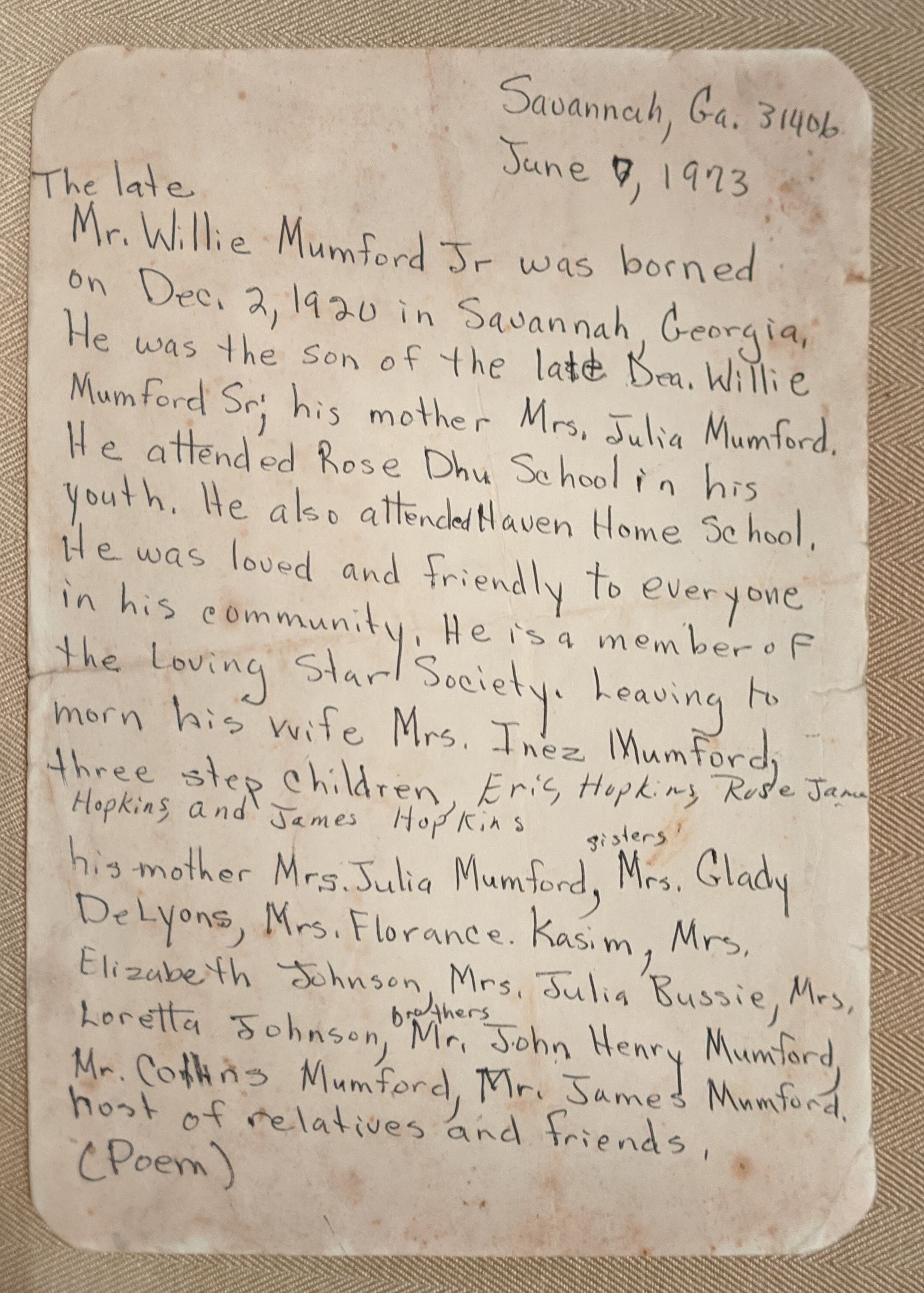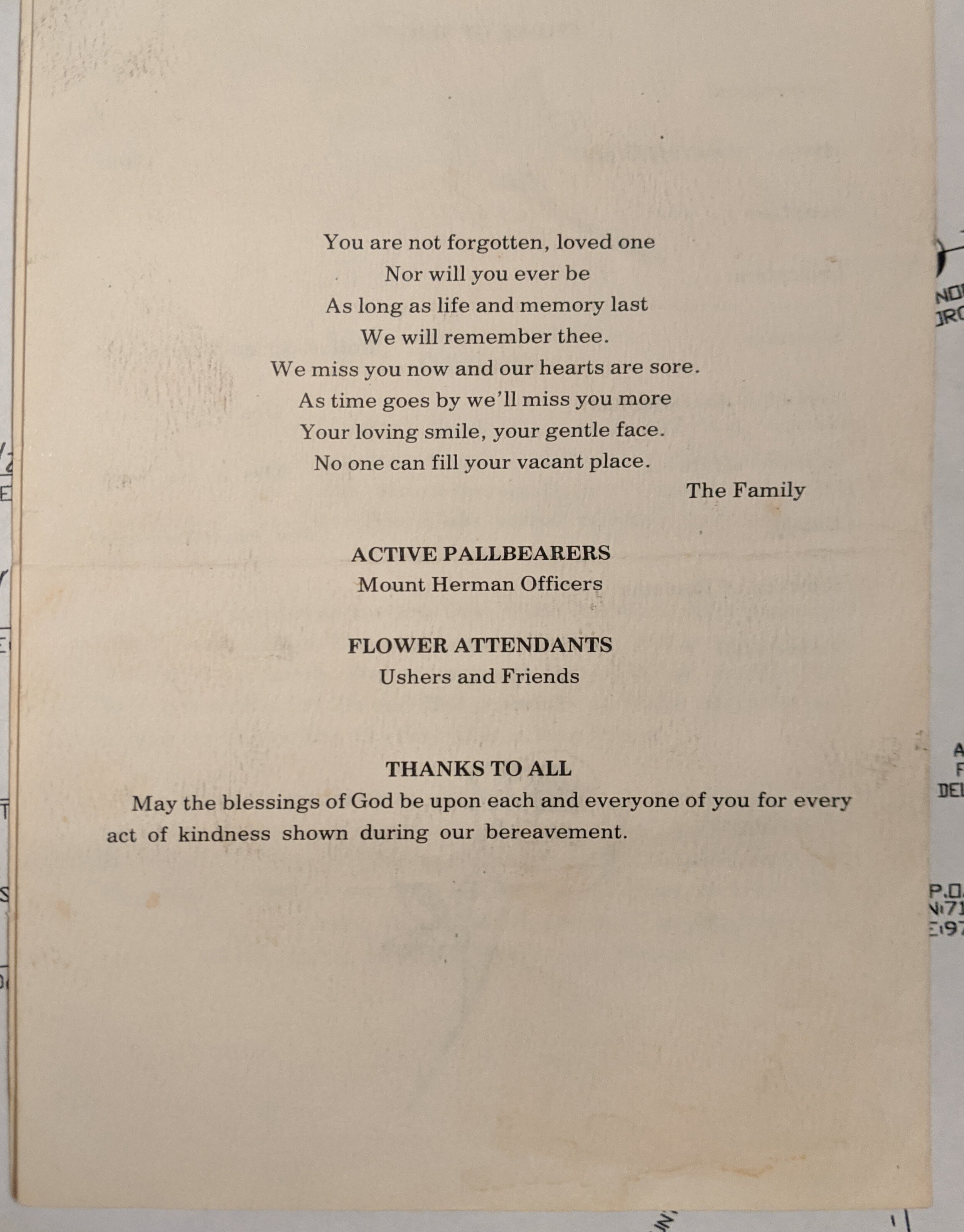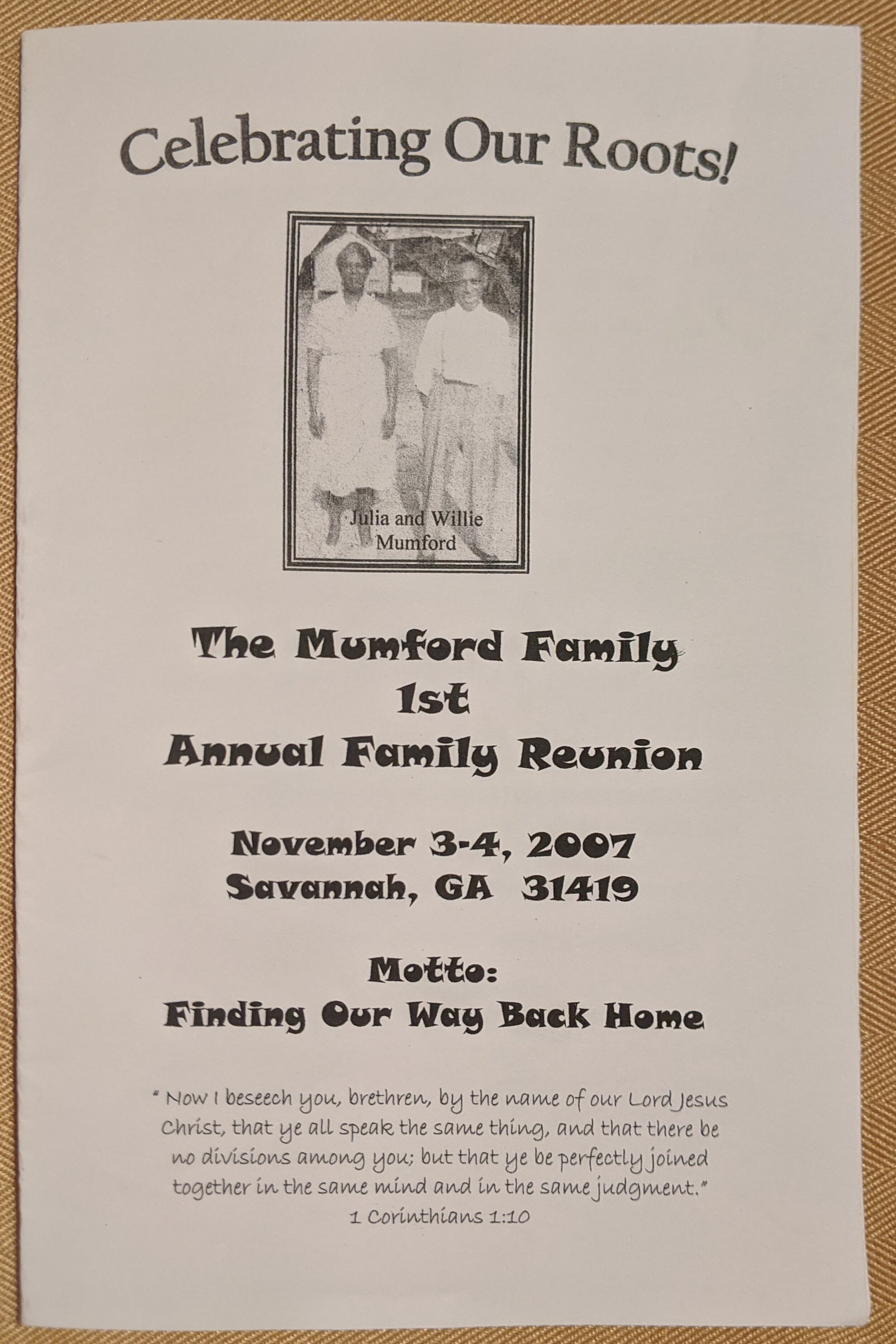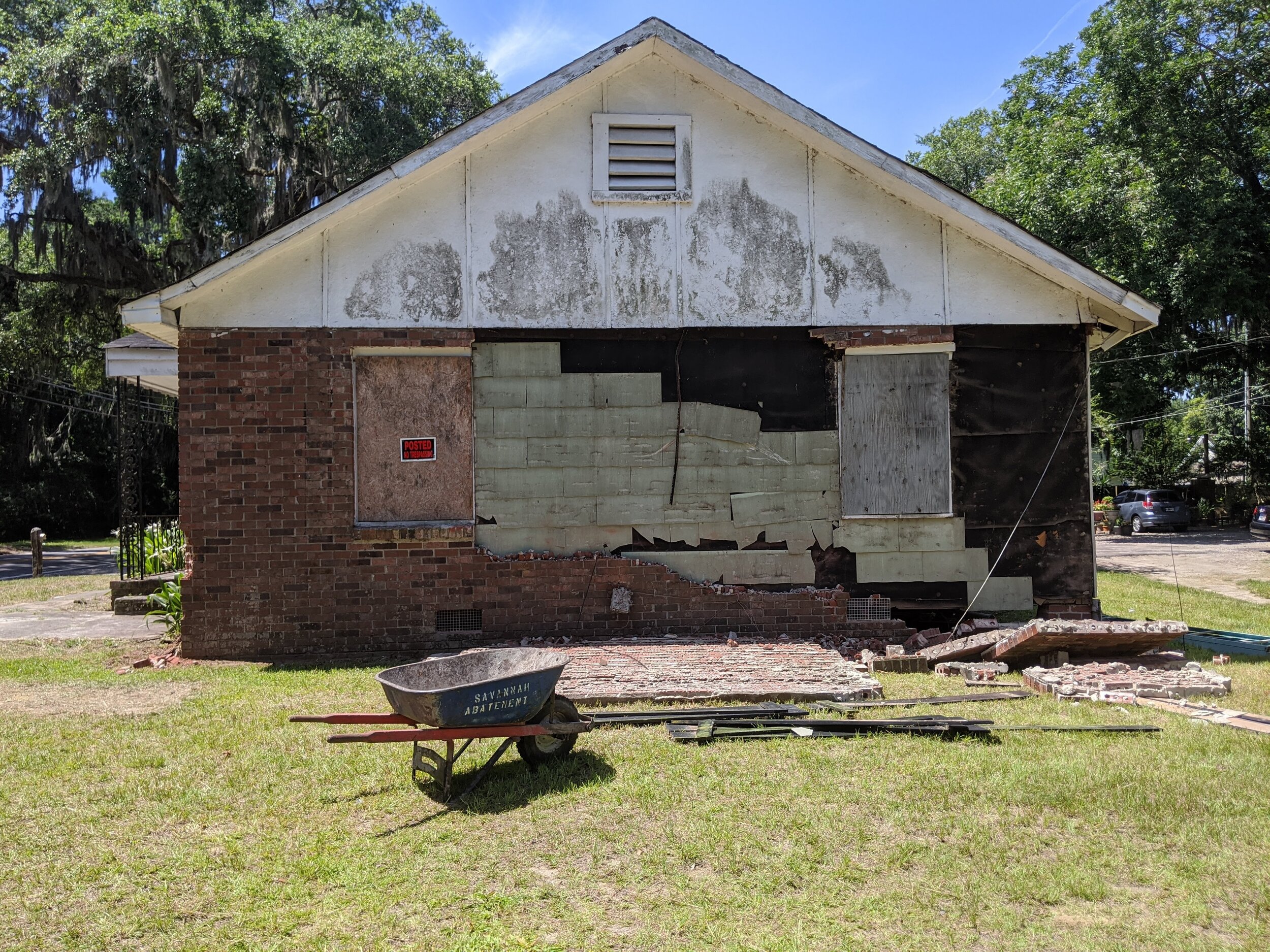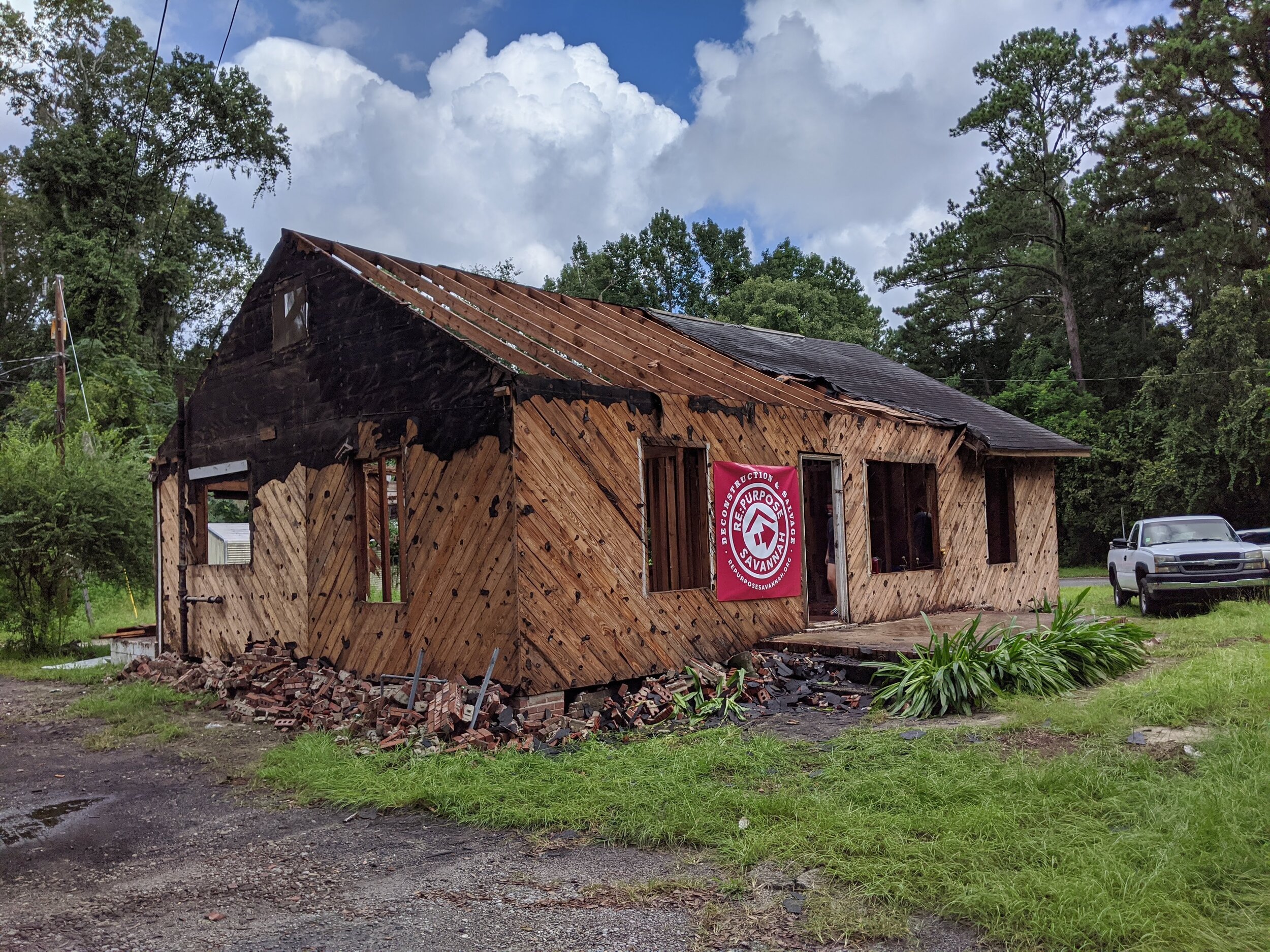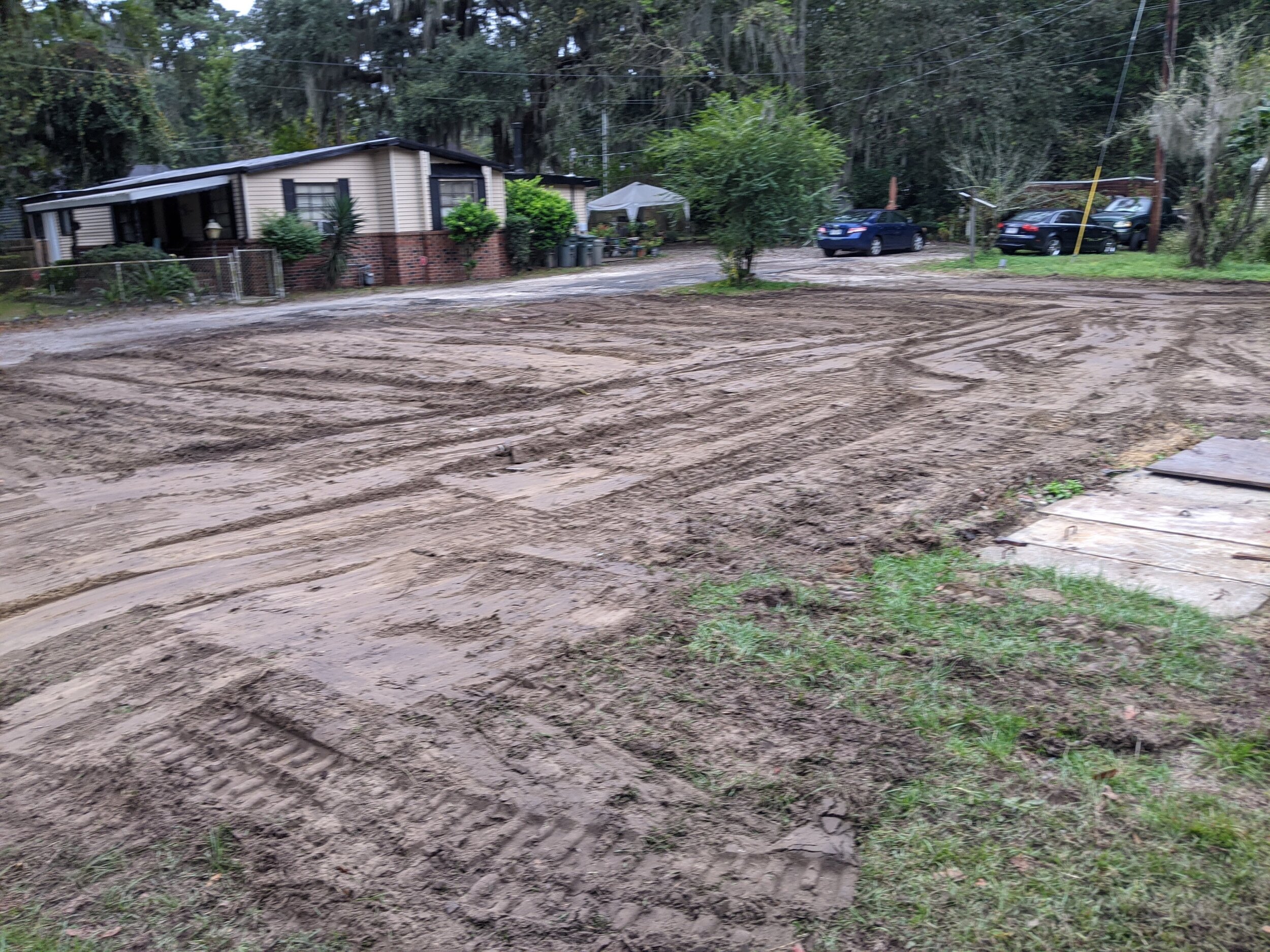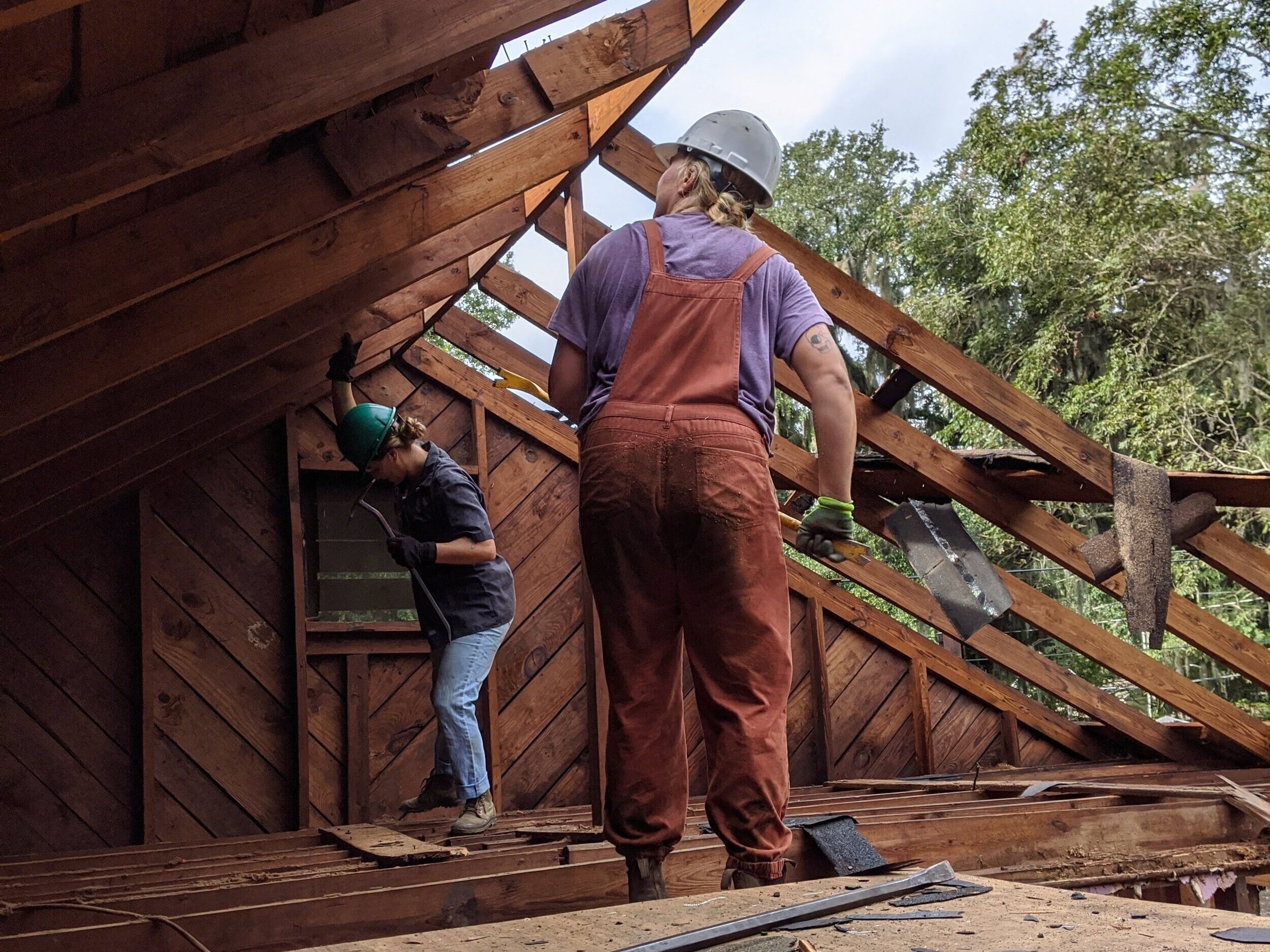COMPLETED OCTOBER 2020
Mama Lizzie’s House
Left: Photo taken in May 2020
The historic Coffee Bluff neighborhood is located between the Vernon River and the Little Ogeechee River, approximately 10 miles south of Savannah’s historic district.
After the emancipation of enslaved people in the South, Coffee Bluff was settled by freed folk departing the plantations of nearby islands. This home embodies the legacy of the many Black families that settled the area and that live in Coffee Bluff today.
In Loving Remembrance
Mama Lizzie’s house was located at 14005 Coffee Bluff road in the historic Coffee Bluff neighborhood. It is named for the matriarch of a family that has lived in Coffee Bluff for generations. Mama Lizzie is the moniker of Elizabeth M. Johnson, the late mother of our client Mary Simmons.
Mrs. Johnson, known as Mama Lizzie by many in the neighborhood, played an important role in the Coffee Bluff community. She is remembered for watching over generations of the neighborhood’s children as they gathered on her corner to board the school bus. She was married to Mr. Clyde Johnson, Mary’s father, who built the home. Together they had five children, four girls and one boy. Mary fondly remembers the family’s pride in the brickwork, laid by hand by her brother and other family members. Mr. Johnson played an important role in the community as well, serving as pastor of a local church and as community barber, providing haircuts to many in the neighborhood on the family’s screened back porch. Mr. Johnson worked during the week for the Swift Meat Packing Company. This beloved couple is remembered by their children, grandchildren, and great-grandchildren living in Coffee Bluff today.
Mary with her daughter and granddaughter
A Family Legacy
The first known development of Coffee Bluff is the establishment of two plantations, Rosedew and the Retreat, on lands granted by the British crown to Sir Patrick Houston following his arrival from Scotland in 1734. These plantations and many others throughout the barrier islands, including Ossabaw Island, operated until the end of the Civil War in 1865.
On January 16, 1865, General Sherman issued Special Field Orders, No. 15, providing the confiscation of 400,000 acres of enslaver land along the Atlantic coast of South Carolina, Georgia, and Florida and the dividing of it into parcels of not more than 40 acres on which were to be settled by approximately 18,000 formerly enslaved families and other Black people then living in the area.
On September 12, 1865, under Circular 15, President Andrew Johnson “revoked the right to land promised in Field Order No. 15, and confiscated properties were soon returned to their Confederate owners.” Several of the Black families holding title to land on Ossabaw Island relocated to White Bluff and Coffee Bluff.
The earliest known member of Mary’s family to own land in Coffee Bluff was Mary’s great-great-grandfather, Lawrence Jones, who purchased 12½ acres on Coffee Bluff on February 25, 1882 for $125. The property was described as: “bounded on the north by lands of Robert W. Walls, on the east by Montgomery river, on the south by ‘Coffee Bluff’ and ‘Rose Dew’ plantations and on the west by lands of the late Patrick Houston.”
Lawrence Jones passed his property down to his daughter Cornelia Jones, Mary’s great-grandmother. Cornelia “Mama Nelia” Jones passed her land to her daughter Julia Jones Mumford, Mary’s grandmother, who lived in an older house directly next to Mama Lizzie’s, on the same parcel that Mary owns today. Traces of the piers of Julia’s home are still visible on the property. Julia’s daughter Elizabeth (Mama Lizzie) and her husband built their home next door, and there they raised their children, among them, Mary.
Julia Jones Mumford and Willie Mumford in front of the First Mount Pleasant Baptist Church
Mary’s niece on her first day of school in front of Mama Lizzie’s house before the brick veneer was added
Mama Lizzie’s circa 1970
Family Tree illustrated by Mary
Family Reunion portrait, 2007
Deep roots
Handwritten documents, some by Mama Lizzie herself, capture the handing down of history as well as property through generations.
Programs from significant events trace close ties to the community.
inspiration for the future
In the early 1980s, a large oak tree was felled by a storm and caused severe damage to the house. Upon her mother’s passing, Mary spent years consolidating ownership of the land from her siblings. When she finally succeeded in gaining sole ownership of the property, Mary engaged our services for structural removal.
Wood cladding beneath the brick veneer.
Severe tree damage to the rear of the house.
Mid-century framing.
Mary lends a hand pulling nails.
Mary’s passion for the project of keeping her family’s property is an inspiring testament to the strength of heritage, legacy, and community ties to the land.
Mary is currently designing a new home to be built on the property, inspired by the memory of her parents, incorporating many beautiful materials from Mama Lizzie’s house into her new home. She plans to leave the home to her daughter and granddaughter who live in the neighborhood today.
Mary reviews design ideas for her new home
RECLAIMED: 15 tons
RECYCLED: 19 tons
LANDFILL: 0 tons
A Dignified End
Our role in the story of Mama Lizzie’s was to provide a needed service: the removal of the house. Mary was drawn to our process because of the pain of releasing the house to the past. Many experience emotional hardship seeing the homes of their loved ones brutally demolished and vanished from the landscape. We were honored to gently deconstruct and reclaim the beautiful materials inside, preserving many elements that will find a new life in Mary’s future home. Every piece of Mama Lizzie’s house that was unfit for reuse was recycled through our local partner Green Acres.
Coffee Bluff Road
Coffee Bluff/White Bluff Road itself played a significant role in the history of the Savannah area. Coffee Bluff Road is the last leg of a long historic path that begins in the heart of downtown Savannah. The road begins as Bull Street at the intersection of Bay Street on the bluff overlooking the Savannah River. Bull Street was the “main street” of the original Savannah colony and remains the central road traversing Savannah’s many historic districts, often referred to as “Monument Row” due to the significant monuments placed in squares along the length of Bull Street. When the road crosses DeRenne Avenue it becomes White Bluff Road, continuing south for several miles before transitioning again into Coffee Bluff road, which was originally a toll road. The road connects the Savannah River at its beginning to the Little Ogeechee River at its end, passing a long stretch of the Vernon River. This historic pathway connects these waterways and provided transit to the folks that fished the more remote waters with the important trading hub in downtown Savannah.
The Crusader Club
In 1954, the Crusader Club was founded “to provide recreational services for youth and seniors in the community. The mission is to enhance the quality of life for residents in the White Bluff/Coffee Bluff area. Our vision includes preserving our cultural identity for future generations to know the legacy from freed slaves settling in this community.”
In 2018, The Crusader Club proposed historic markers in White/Coffee Bluff to “provide more insight on the importance of the public waterways for preserving the cultural identity of African-Americans settling in the White Bluff/Coffee Bluff community… The goal of these markers is to tell the story and enhance interest in preserving the rich history in this community as it relates to the waterways.”
According to the Crusader Club historic marker application “The close proximity of St. Catherine’s Island, Ossabaw Island, and Sapelo Island… was important to the intermingling of slaves and the eventual settlement in White Bluff/Coffee Bluff. They used their skills with fishing, shellfish, and agriculture in this new community.”
Four historic markers were erected on February 22, 2019
We humbly thank the Crusader Club for their research and activism that has brought light to the histories of Coffee Bluff and White Bluff.
Press Articles
Southside Savannah community celebrates African-American history
New historical markers unveiled at White Bluff, Coffee Bluff areas
SOurces
Georgia Writer’s Project. Drums and Shadows: Survival Studies Among the Georgia Coastal Negroes, 1940.
Georgia Historical Society. https://georgiahistory.com/education-outreach/online-exhibits/featured-historical-figures/additional-featured-historical-figures/patrick-houstoun/
Dorsey, Allison. “The great cry of our people is land!” Black Settlement and Community Development on Ossabaw Island, Georgia, 1865 – 1900.” African American Life in the Georgia Lowcountry: The Atlantic World and the Gullah Geechee edited by Philip Morgan. University of Georgia Press, 2010, pp 225 – 252.
Chatham County Deed Book 5D, Folio 71, Margaret Blackwell to Lawrence Jones, February 25, 1882.
Historic Site and Monument Commission, Application for Historical Markers, Monuments and Public Art. http://agenda.savannahga.gov/content/files/coffee-bluff-legacy-markers-mpc-application-010219.pdf
Architectural Renderings
Thanks to volunteers from Savannah Technical College for reconstructing Mama Lizzie’s in digital renderings.
Watch Our Process
#savemamalizzies
Check out our Instagram posts about this project!
Stories Highlights
Watch videos taken on Instagram during our deconstruction!
What is your relationship to Mama Lizzie’s?
Do you have insight into the history of Mama Lizzie’s House? Have you made something out of the materials we reclaimed from Mama Lizzie’s? We would love to collect your histories and re-use stories to share in our growing archive!











